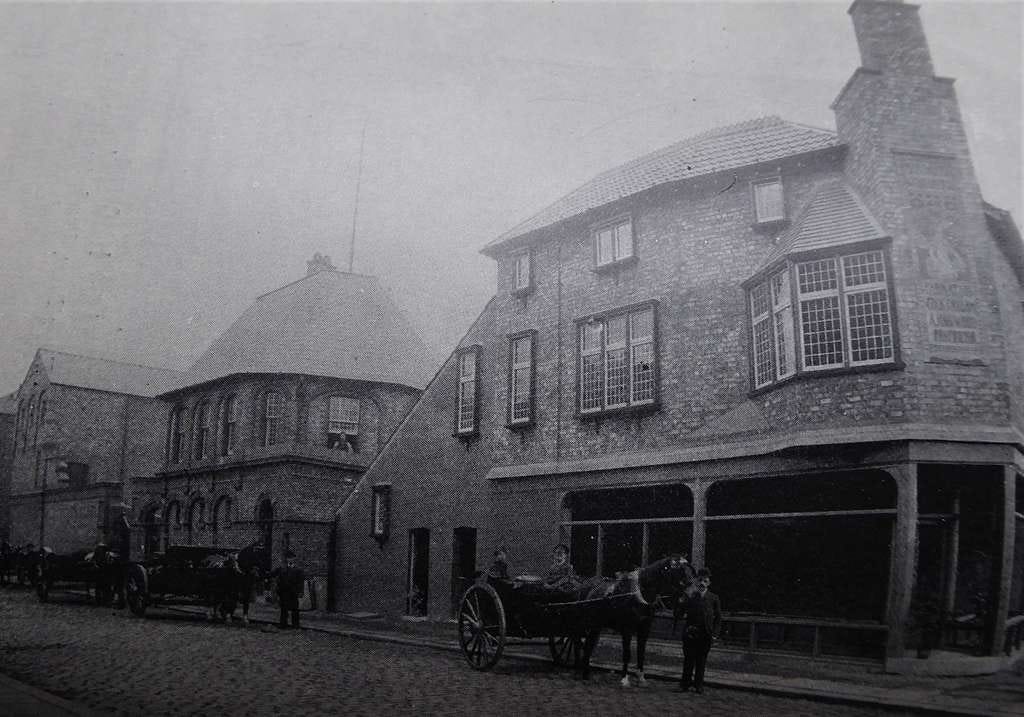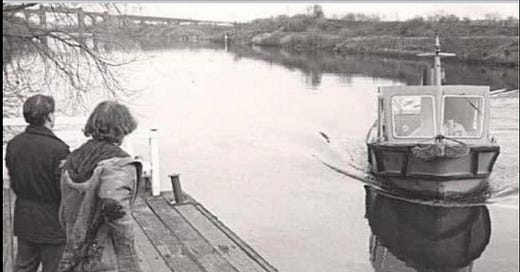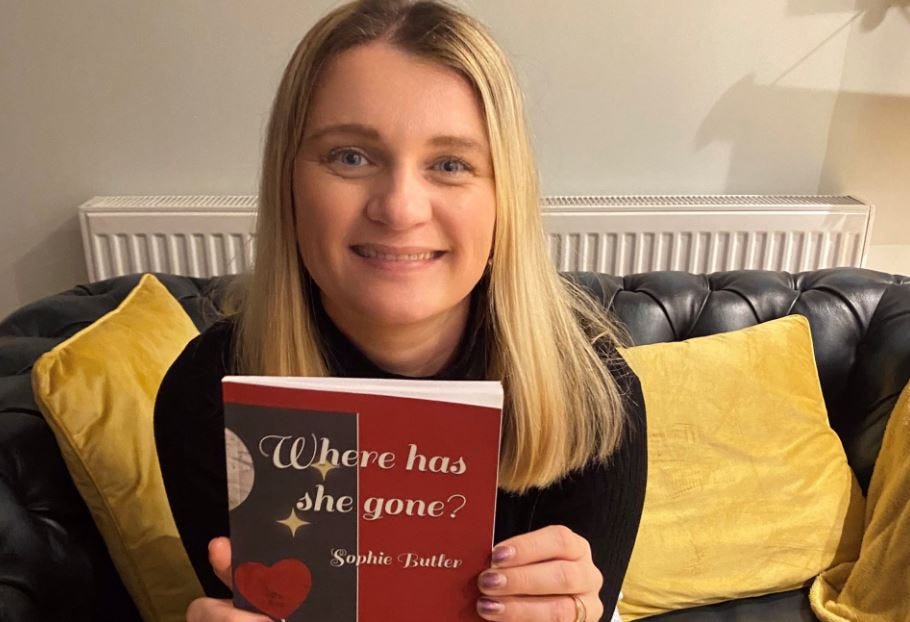'A sad and painful day' - 55 years since the Bob's Ferry disaster
Almost 55 years ago, a tragic accident on the Manchester Ship Canal would devastate families and residents. Decades later, the pain and sadness remains.
In this week’s newsletter, we remember those lost in a devastating accident on the Manchester Ship Canal.
If you enjoyed it please forward this newsletter to someone who might enjoy it. Got a tip? Let us know at Now@Salford.ac.uk
“I could see flames shooting across the sky”
Lynn Taylor stood at her bedroom window on April 14th 1970, watching her Dad get his bike out of the shed for his commute to the steelworks. Just a few hundred feet away from Dudley Road in Cadishead, where she lived, a huge explosion suddenly filled the horizon. Some reports put the extent of the conflagration at a mile long and 60 feet high. “I could see flames shooting across the sky at the back of the tar works, alongside the canal,” Lynn told me, “I had never seen flames like it, and the way they spread was frightening.” A hellish red glow emerged from the Manchester Ship Canal.
Then 15-year-old Lynn lived close enough to the canal to be affected by one of the worst tragedies to hit Salford after WWII. That morning the Bob’s Ferry service was completing the usual trips of taking workers between Cadishead and Partington.
Steel was a huge employer in Cadishead and Partington; as a result many of the area’s men were desperate to get to work on time, in case they were docked pay. However, Ferryman Bernard Carroll had noticed a strange smell, which hung in the air and made people sick. As a result he halted the open boat ferry service, over safety concerns, and tried to raise the alarm with other boats. With the quickest link across the Ship Canal being Bob’s Ferry, the steelworkers, in frustration, started using nearby rowing boats to reach the other side of the canal.
Unknown to the workers was the fact that up to 14,000 gallons of flammable liquid had accidentally poured into the Ship Canal from a nearby vessel being loaded with 1800 tons of fuel. Allegedly, when one of the workers flicked a cigarette butt into the water, the canal became engulfed in flames.
People near to the canal reportedly watched as the ferry passengers dived into the cold waters, in the hope of escaping the fire. Bernard Carroll, who had set out to help the drifting boat halfway across the canal, was also engulfed.
“You could hear the distant horrendous cries, and the smell of burning”, recalls Jacqueline Heaton, who was aged seven, and living on a caravan site in Partington.
Five passengers died, including Carroll, who was 24 at the time, while multiple others were taken to Salford Royal Hospital and the burns unit at Withington Hospital.
Amongst the commuters using the ferry service, who was to perish, was 18-year-old Brian Hillier, who was on his way to work in Patricroft.
“It was such a sad and painful day; for an 18-year-old to go out in the morning and never return...” recalls his sister Cath Quinn. A friend recalls being at The Curzon cinema the night before the incident, watching The Hound of the Baskervilles. Brian’s body was missing for two weeks.
The tragedy had a lasting impact on the families affected: “My Mum and Dad were never the same, especially my Mum,” Brian’s brother, Tony Hillier, told me. “I still think of Brian as a young lad who was just courting — never as he would be now at age 67.”
Only a week before the accident, Brian had become an uncle to a baby girl, Tony’s daughter. “Just before the accident he came to my flat with his new girlfriend, we shared a few beers together,” he recalls.
Eight weeks after the incident, Shell announced an inquiry into the incident. It was later determined that fuel had leaked from the Tacoma, the vessel that was being loaded at the Partington Coal Basin. Two men were supposed to oversee the loading, ensuring no fuel spillages happened. Instead the two men admitted that they had been in the canteen.
The fire sent ripples of sadness throughout communities on both sides of the water. “I remember being in the playground at Broadoak School, we could see plumes of smoke,” Gary Kanes, of Partington, remembers. “I remember my mother crying because a good friend of hers had died in the tragedy” he said.
Another man, Robert Salmon, lived nearby on Lytherton Avenue, Cadishead. He awoke to smoke in the sky, and was the first person to contact the emergency services. He was later a witness at the inquest, which was held in Eccles. The inquest concluded a verdict of ‘death by misadventure’ for those that died.

The story of the fire was told to me in hushed tones by my grandma. Growing up in Irlam, I frequented the locks over the Manchester Ship Canal to Flixton, and my grandma was always cautious about being so close to the water. I often asked as a child why there wasn't a little boat we could hop onto, and that's where the story of the Bob’s Ferry Disaster originated for me. It’s worth mentioning that the tragedy is also known by different names, those in Partington know it as the Partington Ferry Disaster, whilst others remember it as the Bob’s Lane Ferry Disaster.
Since then, the memories of those involved have been kept alive. In 2014, a memorial trip was organised taking 232 passengers from Salford Quays to Liverpool. As they reached Irlam and Cadishead, the boat stopped, allowing family members and friends to lay a wreath to the memory of the victims. Members of Salford City Council, Trafford Council, Shell UK, Peel Holdings and the Irlam Rotary Club were also in attendance.
“After the accident, none of my friends were allowed to visit the ferry,” recalls Gail Shakley, Bernard Carroll’s niece. “Their parents were very wary after the explosion.”
Later, Gail’s mum, Dorothy, and her stepdad Jim Fogarty took over the ferry service. They moved into a bungalow adjacent to the ferry port: “Life at the ferry was a seven-day operation from very early morning until late at night.”
“We grew up with huge Manchester Liners passing by our lounge window; when a ship went past the bungalow would rumble,” Gail recalls. Life after the accident became tough for Gail and her family, her stepdad, Jim Fogarty, got a job doing coach tours, leaving Dorothy to run the ferry service alone. Business plummeted, as workers were too worried about a repeat explosion on the canal and found alternative routes to work.
The ferry’s final service took place on Sunday 18th July, 1993. Today, the only ferry service available in Irlam and Cadishead is the Hulmes Bridge Ferry, paid for by Peel Holdings. It connects Irlam to Flixton, rather than Cadishead to Partington.

Today, the Bob’s Ferry Disaster is commemorated with a memorial plaque on Boat Lane, Cadishead. It notes that six men perished: Brian Hillier, Bernard Carroll, Albert Wimbleton, Roy Platt, Alan Cliff, and Robert Kilgour. Only three men survived: Daniel McAlister, Stephen Hunter, and George Morrell.
The memorial displays some of the key details of the day, but it is the stories and memories of the families affected by the disaster that, I believe, keep that terrible morning alive in our thoughts.
Lockdown loss inspires bestselling poetry book for Monton woman
A woman from Monton has written a bestselling poetry book in memory of her late mother who died during lockdown.
After losing her mother, Rita, during the pandemic, Sophie Butler, a mum of three from Salford, has captured hearts and resonated deeply with readers through her poignant poetry collection, “Where Has She Gone?” Read more here.
Burns Night celebrations brings spirit of Scotland to Broughton House
Residents of Broughton House Veteran Care Village were able to tuck into a Burns Night supper for the traditional Scottish celebration.
The celebration of the life and work of the famous Scottish poet, saw several Scottish veterans enjoy a real taste of home. Read more here.
Plans submitted for 42 affordable and sustainable homes in Salford
Plans have been submitted for 42 new affordable three bedroom homes in Salford that will form part of Adelphi Village.
The proposal made by ECF (formerly The English Cities Fund) will hope to introduce a residential community situated to the east of the River Irwell. Read more here.
Criminal gang who kidnapped vulnerable man for cryptocurrency have been jailed for 76 years
A criminal gang who kidnapped a vulnerable man in Irlam for cryptocurrency have been jailed for 76 years.
Several men have been found guilty at Manchester Crown Court today (Thursday 30 January) after they violently assaulted and tied up the victim on multiple occasions. Read more here.
What’s On in Salford this week
🧧 Chinese New Year Lion Dance Performance - Residents of Salford will be invited to Kargo MKT to see an electrifying Lion Dance Performance brought to life with acrobatic movements, synchronized to the rhythmic beats of traditional drums. Find out more here.
🎭 Buffy Revamped - Guests of the Lowry will be able to relive the entire 144 episodes of the hit 90s TV show, Buffy the Vampire Slayer, as told through the eyes of the one person who knows it inside out… Spike. Find out more here.
⚽ Salford City travel to Walsall in the hopes of beating the league leaders. The Ammies who are without a win in the last four games, will be hoping to turn the tide this weekend. Find out more here.
Our photo of the week:

The Creamery was purpose-built for Mr A Hailwood on a site of 1,200 square yards at the junction of Deane Street and Lower Broughton Road.
Hailwood had started as a dairyman in Salford about 1870. Over the next twenty-five years his milk delivery expanded from 7,300 gallons per year to 873,485 gallons in 1896.
Much of the milk for the creamery was brought in daily from Cheshire including some from Hailwood’s own farm.
Then building has since been demolished, with the history of the Creamery lost in the history of Greater Manchester and Salford.
Thank you for reading
All our journalism is written by people working, studying and living in Salford – for the people of Salford. We'll be adding more exclusive writing to future editions. If you value local journalism sign up: it’s free, easy and we’ll never share your data.







